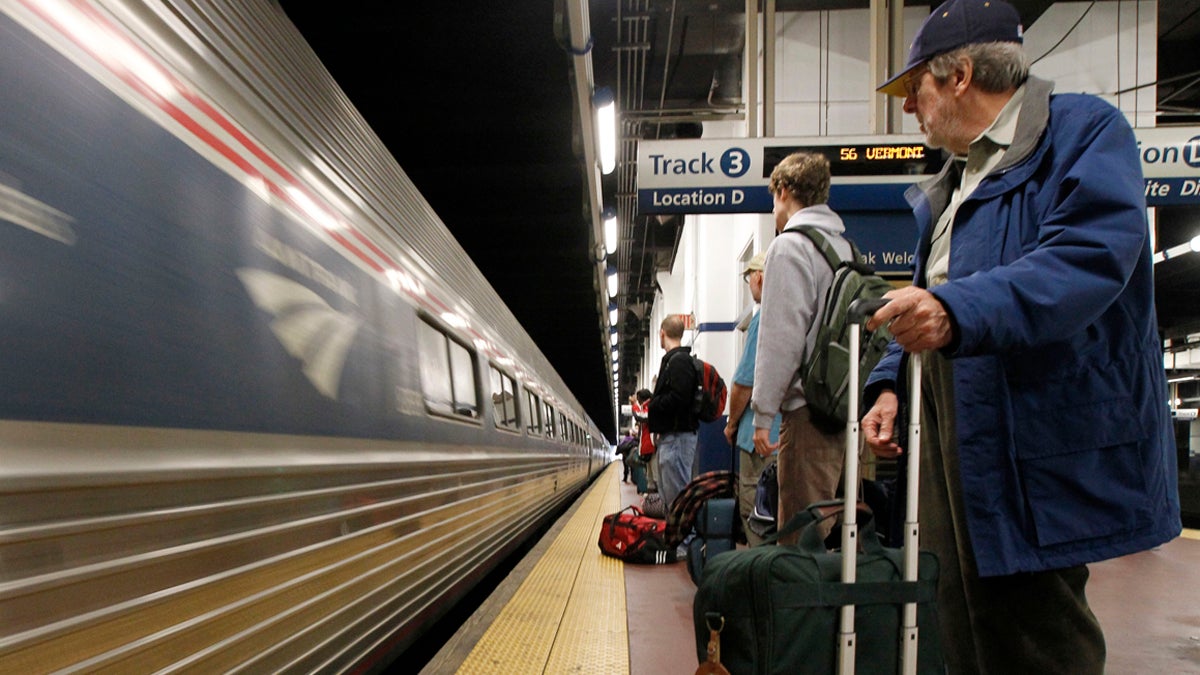For expanding passenger rail in Pa., there’s high demand but no high-speed options

Passengers wait to board an Amtrak train at 30th Street Station in Philadelphia. Pennsylvanians wants more train routes and more frequent trains on existing routes. Those proposals will take time and money. (AP File Photo/Alex Brandon)
Pennsylvanians wants more train routes, and more frequent trains on existing routes. Those proposals will take time and money.
Pennsylvania has a long history with railroads, from the Reading to the Pennsy, and train travel through the commonwealth is still popular today. Philadelphia’s 30th Street Station is the third busiest stop in the country. And the Amtrak route through the commonwealth, aptly named the Pennsylvanian, has more seats filled annually than almost any other route in the country.
“It has a higher capacity, meaning more of the available seats are filled, than any train in the Northeast,” said Mark Spada, a board member for Western Pennsylvanians for Passenger Rail. “It’s at a higher capacity than the Acela, the high-speed train from Boston to New York to Washington.”
All of the available seats are filled because, frankly, there aren’t that many seats. Advocates across the state are working to bring more passenger rail options to Pennsylvania, saying there just aren’t enough.
The Lehigh Valley and Northeast Pa. want to create passenger rail lines into New York and New Jersey. And some western Pennsylvanians are pushing for more frequent trains between Pittsburgh and Harrisburg. Right now, there’s only one round-trip a day.
Creating passenger rail systems
For passenger rail advocates in the Lehigh Valley, the area seems perfect for Pennsylvania’s next train. It’s the fastest growing region in the state. The Lehigh Valley Planning Commission estimates that 109,000 residents commute out to work each day, while another 89,000 commute into the Valley.
“Because of our location between New York City and Philadelphia, people are going everywhere,” said Becky Bradley, executive director of the Lehigh Valley Planning Commission. “It’s not like a suburb of Philly, where everyone is going towards Philly.”
In 2010, the Lehigh Valley worked with New Jersey Transit to determine what it would cost to create a train system into New Jersey. It came in at $658.9 million, which was prohibitive.
But recently, the movement has gotten new life from an initiative called “Road to Rails,” which the mayors of Bethlehem, Allentown and Easton are all supporting. It advocates for using existing freight lines to run passenger trains.
“That’s very common,” said Craig Schulz, an Amtrak spokesperson. “Much of our service is reliant on host railroads, where we don’t own the tracks or the infrastructure. We work with all the freight railroads across the country.”
These freight lines are owned by Norfolk Southern. Amtrak already uses its lines for the Pennsylvanian, from Pittsburgh to Harrisburg.
But Bradley says changes in the global trade market have the potential to affect this local effort.
“With the widening of the Panama Canal, we are expecting, at the most conservative estimates, a doubling of freight traffic into the Lehigh Valley in the next 10 years,” she said. “Norfolk Southern tells us they are already concerned about whether the existing lines will be enough.”
At last Friday’s RenewLV Summit for Smart Growth, Amtrak Vice President for Governmental Affairs Joe McHugh showed support for the idea. He suggested running an “inspection train” — a one-off trip that would show the community what passenger rail would look like.
The Allentown native says an inspection train could come as early as next spring. The idea was met with applause and lots of news coverage about the imminent arrival of passenger rail to the region.
But the Lehigh Valley Planning Commission, which controls all transportation funding for the area, wants residents to pump the air brakes.
“The shortest amount of time anywhere in the country where they have put in new rail systems is like 12 years,” said Bradley. “The federal government has said we need to do a [transportation] mode study first. Any study wouldn’t start until 2017, and that would go a good year and a half.”
Slow progress
No place knows the slow pace of passenger rail development more than the Scranton area. Advocates there have been dreaming of a connector between Scranton and New York City for almost 25 years.
Congressman Matt Cartwright told the Scranton Times-Tribune in October, “it’s one of my dearest dreams to bring commuter rail back to Pennsylvania, and it is a gargantuan-size problem. Many hard-working and intelligent people have tried and failed at this over the last 25 years.”
But the project, estimated to cost $551 million, may be on track again. In October, PennDOT, the Federal Transportation Administration and the New Jersey transit system met in Scranton to talk about passenger rail.
All of those players are important, but since 2013, most of the impetus has been on PennDOT. Federal legislation changed the funding structure so that any train route less than 750 miles is now funded by the state.
“So, PennDOT is the driving force behind deciding whether or not to run a new line like this,” said Schulz. “We will work with the state, because we believe strongly in the economic benefit that passenger rails bring to communities. But Amtrak isn’t the driving force.”
And when it comes to creating new passenger rail services, PennDOT spokesman Rich Kirkpatrick says there are “challenges.”
“Starting a new service from scratch would entail multiple parties, a lot of cost and the willingness of all parties to share in that cost,” said Kirkpatrick. “We have resources to keep what we have in relatively good shape. But we can’t start a service that will set us back financially.”
Go west…conveniently
Starting a new service can be costly. Advocates with Western Pennsylvanians for Passenger Rail think they have a plan to expand passenger rail service without starting from scratch.
Currently, Amtrak runs 13 trains a day between Harrisburg and Philadelphia and on to New York. But between Pittsburgh to Harrisburg? Just one.
“For some of these communities that the train passes through, this train is their main public transportation,” said Western Pennsylvanians for Passenger Rail’s Spada. “We’d like to see PennDOT increase the number of trains by at least two.”
PennDOT has asked Amtrak for information on how much it would cost to add a train each day. Kirkpatrick says the agency has not heard back yet.
The Pennsylvanian has stops in towns like Lewistown, Altoona, Huntingdon and others that aren’t serviced by major bus lines. The only way in and out of town is by car or on the once a day train.
That’s a problem for both ends of the age spectrum. In an aging community like Lewistown, residents say they want to be able to travel without driving long distances. But in Huntingdon, where Juniata College is located, students and young people want to be able to get in and out without owning a car.
Spada believes that there is seriously unmet demand — which could make additional trains financially viable. His group, along with the Pittsburgh Downtown Partnership, produced a study examining the cost of increasing train frequency to three a day.
“We have existing service and ridership numbers that can be used to make some calculations in the planning,” said Spada. “We have hard facts that ridership would increase with more train lines.”
PennDOT agrees.
“We have seen that one of the secrets to the success of the Keystone Corridor between Harrisburg and Philadelphia is the frequency of the service, virtually hourly service,” said Kirkpatrick. “That, and the speed of the service.”
That’s one thing western Pennsylvania has going against it. From the horseshoe curve in Altoona to the mountainous terrain in the middle of the state, increasing the speed of the trains would take an estimated $1 billion in infrastructure.
Spada says those west of Harrisburg would happily settle for an additional, albeit slow, train a day.
WHYY is your source for fact-based, in-depth journalism and information. As a nonprofit organization, we rely on financial support from readers like you. Please give today.


